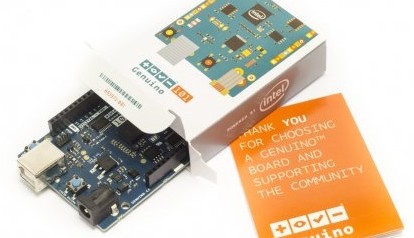First Steps With Arduino/Genuino 101
January 12, 2016
on
on

Announced at the Rome Maker Faire 2015, the new Intel Curie-based Arduino/Genuino 101 board is now shipping. One of these boards landed on my desk, and so I gave it a try.
Because I am located outside the USA, the board I received was labeled Genuino 101; in the USA it is sold as Arduino 101. This naming convention is bound to confuse more than one especially if you know that there exists also an Arduino Industrial 101, which is sold world-wide by arduino.org. For this reason I will refer to the new board only as Genuino 101.
Note: This review was done using Windows 7 Family Edition, SP1.
According to arduino.cc, the 101 is meant to be the successor of the Uno. This is rather surprising as the two boards are light-years apart. Whereas the Uno is based on an (impressive, I admit) 8-bit microcontroller, the 101 has two 32-bit cores on board in the shape of an Intel Curie system-on-chip (SoC). One of these cores is an x86 core, so genetically speaking the 101 is probably closer to a PC than to a Uno. Also the 101 has more than ten times as much memory as the Uno.
Another important difference is that the Uno is more a kind of break-out board for the ATmega328 (with a serial-to-USB converter), wheras the 101 has its own peripherals like a 6-axis accelerometer/gyroscope and a Bluetooth Low Energy (BLE) radio (noticed the PCB antenna?). Where you have full control over the MCU on the Uno, you can (for now) hardly access the Curie.
Important to know also is that the 101 is not 100% Uno compatible. It has only four PWM outputs (six for the UNO, note that the documentation below the spec list is contradictory and mentions 7 PWM outputs for the 101) and it runs from 3.3 volts. Level shifters make the I/O pins 5V compatible. However, the analog inputs go through a level shifter too, meaning that analog input signals are limited to 3.3 volts.
Because I am located outside the USA, the board I received was labeled Genuino 101; in the USA it is sold as Arduino 101. This naming convention is bound to confuse more than one especially if you know that there exists also an Arduino Industrial 101, which is sold world-wide by arduino.org. For this reason I will refer to the new board only as Genuino 101.
Note: This review was done using Windows 7 Family Edition, SP1.
According to arduino.cc, the 101 is meant to be the successor of the Uno. This is rather surprising as the two boards are light-years apart. Whereas the Uno is based on an (impressive, I admit) 8-bit microcontroller, the 101 has two 32-bit cores on board in the shape of an Intel Curie system-on-chip (SoC). One of these cores is an x86 core, so genetically speaking the 101 is probably closer to a PC than to a Uno. Also the 101 has more than ten times as much memory as the Uno.
Another important difference is that the Uno is more a kind of break-out board for the ATmega328 (with a serial-to-USB converter), wheras the 101 has its own peripherals like a 6-axis accelerometer/gyroscope and a Bluetooth Low Energy (BLE) radio (noticed the PCB antenna?). Where you have full control over the MCU on the Uno, you can (for now) hardly access the Curie.
Important to know also is that the 101 is not 100% Uno compatible. It has only four PWM outputs (six for the UNO, note that the documentation below the spec list is contradictory and mentions 7 PWM outputs for the 101) and it runs from 3.3 volts. Level shifters make the I/O pins 5V compatible. However, the analog inputs go through a level shifter too, meaning that analog input signals are limited to 3.3 volts.
Read full article
Hide full article



Discussion (0 comments)